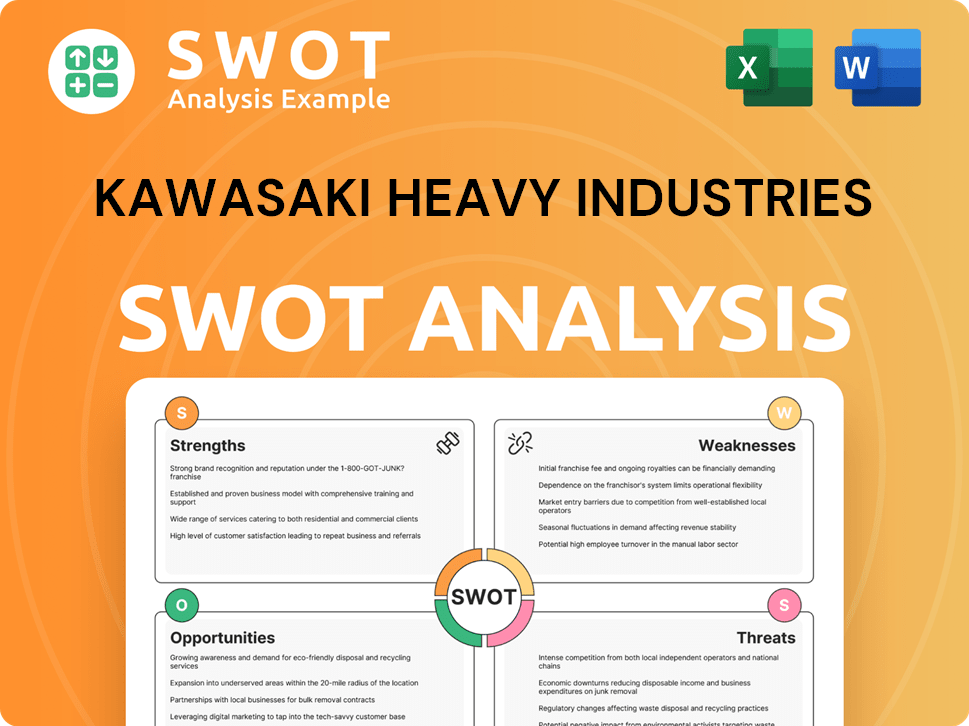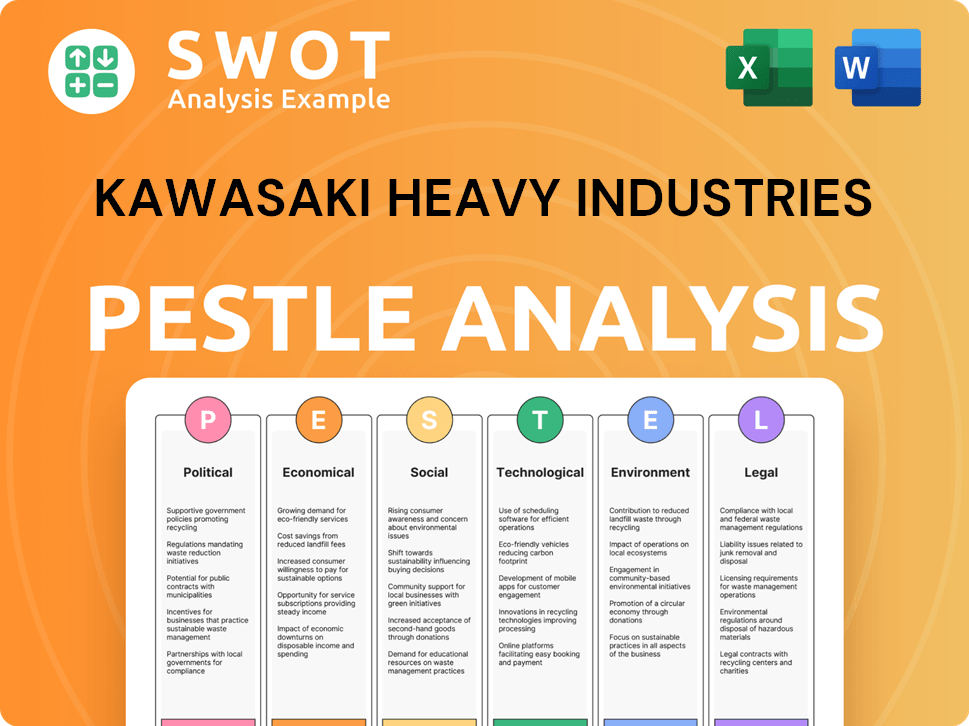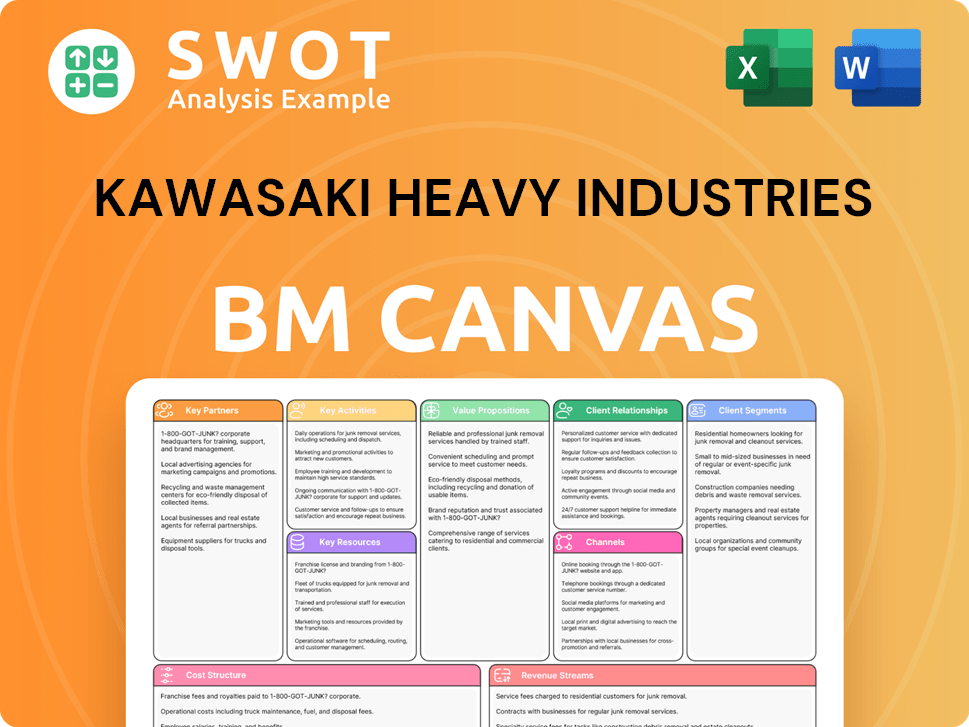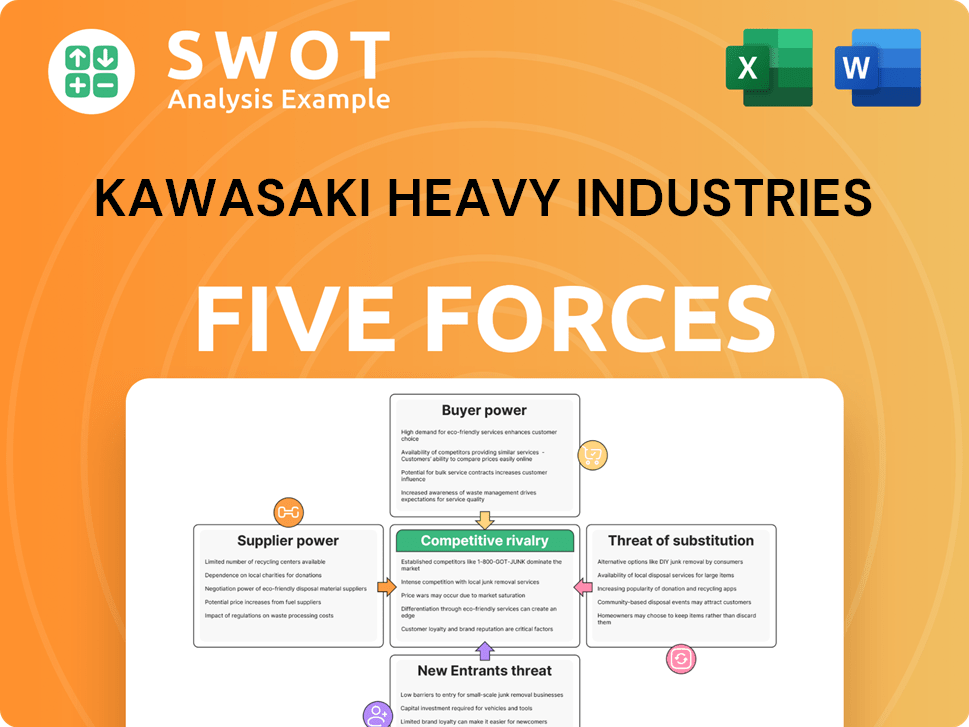Kawasaki Heavy Industries Bundle
How Does Kawasaki Heavy Industries Stack Up Against the Competition?
From roaring motorcycles to cutting-edge aerospace technology, Kawasaki Heavy Industries (KHI) is a global force. But who are its main rivals, and how does KHI maintain its edge in a fiercely contested market? This deep dive into the Kawasaki Heavy Industries SWOT Analysis unveils the strategies and challenges shaping KHI's future.

This comprehensive Kawasaki Heavy Industries SWOT Analysis provides a detailed market analysis, examining the competitive landscape and industry rivals. We'll explore KHI's competitive advantages, its global presence, and the key factors influencing its financial performance comparison, offering insights for informed decision-making.
Where Does Kawasaki Heavy Industries’ Stand in the Current Market?
Kawasaki Heavy Industries (KHI) is a global conglomerate with a diverse portfolio spanning multiple sectors. Its operations include motorcycles, rolling stock, aerospace, energy systems, and shipbuilding. KHI serves a wide array of customers worldwide, establishing a significant presence in various industries.
KHI's financial performance for the fiscal year ending March 31, 2025, reveals substantial growth. Revenue increased by 15.1% to ¥2,129.3 billion (approximately $13.6 billion USD), and business profit surged by 209.8% to ¥143.1 billion (approximately $916 million USD). This robust financial performance highlights KHI's strong market position and operational efficiency.
KHI operates in several key markets, including aerospace, rolling stock, and shipbuilding. The aerospace market was valued at $820.67 billion in 2024 and is projected to reach $875.37 billion in 2025. The global rolling stock market is valued at approximately $72.56 billion in 2025 and is forecasted to reach around $125.23 billion by 2034. KHI's involvement in these sectors positions it within high-growth industries.
The Power Sports & Engine segment is a primary revenue driver, contributing ¥610.7 billion, or 29% of total revenue. The aerospace systems segment also showed strong performance, with a significant revenue increase and a positive business profit turnaround. These segments are crucial to KHI's overall financial success and market presence.
KHI's financial health is robust, with total assets reaching ¥3,016.9 billion (approximately $19.3 billion USD) and equity attributable to owners of the parent increasing to ¥702.9 billion (approximately $4.5 billion USD). This strong financial standing supports KHI's competitive positioning and future growth prospects. For more insights into their strategic approach, consider reading about the Growth Strategy of Kawasaki Heavy Industries.
The competitive landscape varies across KHI's business segments. In the motorcycle market, KHI faces intense competition. The global shipbuilding market was valued at $163.66 billion in 2024 and is expected to reach $170.51 billion by the end of 2025. The heavy construction equipment market was valued at $217.21 billion in 2025 and is projected to reach $297.27 billion by 2033, growing at a CAGR of 4.0%.
KHI's strategic positioning is influenced by its diversified business model and its presence in growing markets. The company's ability to adapt to market changes and maintain a strong financial foundation are key to its long-term success. KHI's ability to innovate and capitalize on global market trends will be crucial for maintaining its competitive edge.
- Strong revenue growth in key segments.
- Significant presence in the aerospace and rolling stock markets.
- Robust financial health with increasing assets and equity.
- Competitive challenges in the motorcycle market.
Kawasaki Heavy Industries SWOT Analysis
- Complete SWOT Breakdown
- Fully Customizable
- Editable in Excel & Word
- Professional Formatting
- Investor-Ready Format

Who Are the Main Competitors Challenging Kawasaki Heavy Industries?
The competitive landscape for Kawasaki Heavy Industries (KHI) is complex, encompassing diverse sectors from heavy machinery to motorcycles and aerospace. This overview provides a detailed market analysis of KHI's key competitors across its various business segments, highlighting the challenges and opportunities in each sector.
KHI faces significant competition, requiring it to continually innovate and adapt to maintain its market position. Understanding the strengths and strategies of its rivals is crucial for KHI to make informed decisions and sustain its growth in a dynamic global market. For a deeper understanding of the company's origins, consider reading the Brief History of Kawasaki Heavy Industries.
In this segment, KHI competes with major conglomerates. Mitsubishi Heavy Industries and IHI are direct competitors, often overlapping in aerospace, energy, and heavy equipment. Daifuku and Ebara are also identified as rivals.
KHI competes with global giants in the motorcycle market. Key competitors include Honda Motor Co. Ltd., Yamaha Motor Co. Ltd., Suzuki Motor Corporation, and Harley-Davidson. The Asia-Pacific region dominates, holding a 61.61% market share in 2024.
The rolling stock market sees competition from major international players. Key competitors include CRRC Corporation Limited (China), Siemens AG (Germany), Alstom SA (France), Stadler Rail AG (Switzerland), and Wabtec Corporation (US). These companies compete on technology, project scale, and cost-effectiveness.
In aerospace and defense, KHI faces competition from major global players. The market is characterized by intense competition from companies like Boeing, Airbus, Lockheed Martin, and Northrop Grumman, depending on the specific product or service.
KHI competes with companies like Donaldson Company. Other competitors include DMG Mori, OKK Corporation, and GF Machining Solutions. This segment is driven by demand for high-precision components.
Competition in shipbuilding comes from major shipbuilding companies. Key competitors include Hyundai Heavy Industries, Daewoo Shipbuilding & Marine Engineering, and Samsung Heavy Industries. The market is focused on eco-friendly vessels and naval modernization.
Emerging players and technological advancements are disrupting the competitive landscape. The increasing focus on electric vehicles, including motorcycles, is creating new competitive pressures. Digital transformation and AI in manufacturing are also significant factors.
- The motorcycle market is highly competitive, with Honda leading global sales with 19.4 million units in 2024.
- The shipbuilding market is driven by eco-friendly vessels and naval modernization.
- KHI must adapt to these changes to maintain its competitive positioning.
- Technological advancements and strategic partnerships are crucial for future success.
Kawasaki Heavy Industries PESTLE Analysis
- Covers All 6 PESTLE Categories
- No Research Needed – Save Hours of Work
- Built by Experts, Trusted by Consultants
- Instant Download, Ready to Use
- 100% Editable, Fully Customizable

What Gives Kawasaki Heavy Industries a Competitive Edge Over Its Rivals?
Understanding the competitive landscape of Kawasaki Heavy Industries (KHI) involves examining its core strengths and strategic positioning within diverse industries. KHI's success stems from its ability to integrate advanced technologies across its segments, from aerospace to marine engineering. This approach enables the company to develop innovative solutions and maintain a strong market presence.
A key aspect of KHI's competitive edge is its brand reputation and customer loyalty, particularly in the power sports segment. This, along with economies of scale and a global network, contributes to cost efficiencies and broad market reach. The company's commitment to research and development, especially in areas like hydrogen technology, further strengthens its position for future growth.
This article provides a detailed look at the competitive advantages that position KHI within its industry. By focusing on technological capabilities, brand equity, operational efficiencies, and strategic initiatives, we can better understand its market dynamics. For further insights into KHI's overall strategy, consider reading about the Growth Strategy of Kawasaki Heavy Industries.
KHI's comprehensive technological capabilities are a significant advantage, spanning aerospace, heavy equipment, and marine engineering. This allows for cross-pollination of innovation and expertise, enabling advanced solutions across its segments. For example, KHI is involved in developing sustainable aquaculture systems and robotic arms.
Brand equity and a reputation for reliability are key strengths for KHI. Its motorcycles are globally recognized for performance and design, fostering strong customer loyalty. The power sports segment was the primary driver of revenue for KHI in the fiscal year 2025, contributing 29% of total revenue.
Economies of scale and a global manufacturing and distribution network provide KHI with cost efficiencies and broad market reach. The company produces a wide range of products, optimizing resource allocation and integrated supply chains. KHI is also expanding its global presence, such as establishing a hydraulic products sales company in Indonesia.
KHI's commitment to research and development, particularly in hydrogen technology and automation, positions it for future growth. The company is involved in joint studies on liquefied hydrogen carriers and has developed robotic arms for advanced applications. Its focus on green technologies demonstrates an adaptive strategy to evolving industry demands.
KHI's competitive advantages are multifaceted, encompassing technological innovation, brand strength, and operational efficiency. These elements enable the company to maintain a strong position in the market and adapt to changing industry dynamics.
- Diversified Technological Capabilities: Spanning aerospace, heavy equipment, and marine engineering.
- Strong Brand Reputation: Especially in the power sports segment, driving customer loyalty.
- Global Manufacturing and Distribution: Providing cost efficiencies and broad market reach.
- Focus on R&D: Particularly in hydrogen technology and automation for future growth.
Kawasaki Heavy Industries Business Model Canvas
- Complete 9-Block Business Model Canvas
- Effortlessly Communicate Your Business Strategy
- Investor-Ready BMC Format
- 100% Editable and Customizable
- Clear and Structured Layout

What Industry Trends Are Reshaping Kawasaki Heavy Industries’s Competitive Landscape?
The competitive landscape for Kawasaki Heavy Industries (KHI) is dynamic, shaped by industry trends and global economic factors. As a major player, KHI's position is influenced by its diverse business segments, including energy, aerospace, and transportation. A thorough market analysis reveals both opportunities and challenges that will define its future trajectory. For a deeper understanding, consider exploring the Target Market of Kawasaki Heavy Industries.
KHI faces risks from economic shifts, geopolitical tensions, and supply chain disruptions. These factors can impact its financial performance and market share. However, the company's future outlook remains positive, driven by its strategic investments and focus on innovation, particularly in sustainable technologies and automation.
The industry is seeing a significant shift toward sustainability and decarbonization, particularly in energy systems, marine engineering, and rolling stock. Technological advancements like digitalization, automation, and AI are transforming manufacturing and operations across all segments. Urbanization and the increasing demand for efficient transportation are driving growth in rolling stock and motorcycle markets.
KHI faces challenges from global economic shifts, geopolitical tensions, and supply chain disruptions. Compliance issues, such as those in fiscal year 2024, also pose a challenge to the company's reputation and operations. Increased competition from industry rivals and fluctuations in raw material costs can impact profitability.
KHI can capitalize on the growing energy storage systems market, projected to reach USD 225.13 billion by 2034. The company can also benefit from the increasing demand for energy-efficient vessels and advancements in automation and AI. Strategic partnerships and diversification into new areas like aquaculture also provide growth opportunities.
KHI is investing in research and development, particularly in hydrogen and automation technologies. The company is focusing on strengthening its compliance and governance systems. These efforts aim to drive innovation, maintain a competitive edge, and ensure long-term resilience in the market.
The global rolling stock market is expected to reach USD 56.93 billion in 2025, with a CAGR of 6.5%. The global motorcycle market is projected to grow from $75.82 billion in 2025 to $119.09 billion by 2032. The precision engineering machines market is projected to grow from USD 20.09 billion in 2025 to approximately USD 29.16 billion by 2034.
- Energy Storage Systems: Market projected to reach USD 225.13 billion by 2034.
- Rolling Stock Market: Expected to reach USD 56.93 billion in 2025.
- Motorcycle Market: Projected to reach $119.09 billion by 2032.
- Precision Engineering Machines: Market expected to reach approximately USD 29.16 billion by 2034.
Kawasaki Heavy Industries Porter's Five Forces Analysis
- Covers All 5 Competitive Forces in Detail
- Structured for Consultants, Students, and Founders
- 100% Editable in Microsoft Word & Excel
- Instant Digital Download – Use Immediately
- Compatible with Mac & PC – Fully Unlocked

Related Blogs
- What are Mission Vision & Core Values of Kawasaki Heavy Industries Company?
- What is Growth Strategy and Future Prospects of Kawasaki Heavy Industries Company?
- How Does Kawasaki Heavy Industries Company Work?
- What is Sales and Marketing Strategy of Kawasaki Heavy Industries Company?
- What is Brief History of Kawasaki Heavy Industries Company?
- Who Owns Kawasaki Heavy Industries Company?
- What is Customer Demographics and Target Market of Kawasaki Heavy Industries Company?
Disclaimer
All information, articles, and product details provided on this website are for general informational and educational purposes only. We do not claim any ownership over, nor do we intend to infringe upon, any trademarks, copyrights, logos, brand names, or other intellectual property mentioned or depicted on this site. Such intellectual property remains the property of its respective owners, and any references here are made solely for identification or informational purposes, without implying any affiliation, endorsement, or partnership.
We make no representations or warranties, express or implied, regarding the accuracy, completeness, or suitability of any content or products presented. Nothing on this website should be construed as legal, tax, investment, financial, medical, or other professional advice. In addition, no part of this site—including articles or product references—constitutes a solicitation, recommendation, endorsement, advertisement, or offer to buy or sell any securities, franchises, or other financial instruments, particularly in jurisdictions where such activity would be unlawful.
All content is of a general nature and may not address the specific circumstances of any individual or entity. It is not a substitute for professional advice or services. Any actions you take based on the information provided here are strictly at your own risk. You accept full responsibility for any decisions or outcomes arising from your use of this website and agree to release us from any liability in connection with your use of, or reliance upon, the content or products found herein.